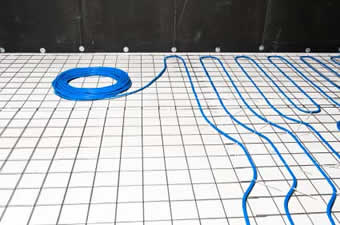How Does Hydronic Heating Work?
In our introduction to hydronic heating we learned that a hydronic radiant system uses piping to circulate hot water throughout the home, which allows the heat from the liquid to radiate into the room at a comfortable and consistent temperature. Now we are going to take a closer look at the details of how this hydronic system works.
Heat Transfer
To understand why hydronic heating is so effective it is important to understand how heat transfer takes place. The transfer of heat occurs in three ways:
- Conduction – This is the movement of heat through objects that physically touch, where heat moves from the warmer object to the colder. Standing barefoot on a beach with hot sand or a cold kitchen tile floor are good examples of this process. Density affects an objects ability to be conductive, which is why liquids are much better conductors than gases. This is the reason why we get colder much faster immersed in 60 degree water, as opposed to standing in outside air temperatures that are the same.
- Convection – This occurs when fluids or gases transfer heat while they are being circulated from one area to another. Traditional heating systems that use forced air are perfect examples of this type of heat movement. Just picture the warm air that flows out of the vents in a room to understand this process. Unfortunately, air and other gases, as mentioned above, are poor conductors of heat.
- Radiation – Thermal radiation is heat that travels in invisible waves through empty space. It is not something that can be blown away by the wind or moved. It is simply absorbed by the person or object that is in the path of the beam of energy, and is a far more effective means of transferring heat.
Hydronic heating works so effectively in keeping your family and home warm over conventional forced air systems because it utilizes conduction and radiation in heat transfer along with a superior conductor of heat in the form of a liquid. On the other hand, forced air heating relies solely on convection and air. Air is such a poor conductor of heat that it is often used as a means of insulation, as can be seen by its use in between the panes of energy efficient windows.

Hydronic Heating Systems in Action
The effectiveness of hydronic radiant heat is produced through 3 steps:
- The boiler system uses conduction to quickly and efficiently heat the water.
- The hot liquid being pumped throughout the house heats the concrete, tile, or other type of flooring through conduction as well as radiates heat into the room.
- Lastly, the flooring surfaces them radiate the heat they gained from the water into the room as well.
The ending result is that a consistent, comfortable temperature radiates from the floor as well as the solid objects around the room. And, a surprising effect is that the radiation of heat in a hydronic system will actually allow you and your family to feel warmer at lower air temperatures than conventional heating. This allows you to further lower your heating bills and energy usage, while increasing your comfort level.
With an understanding of hydronic heating and how radiant systems work, we will now take a look at the different types of hydronic systems, so that you can find the one that best fits your needs.
